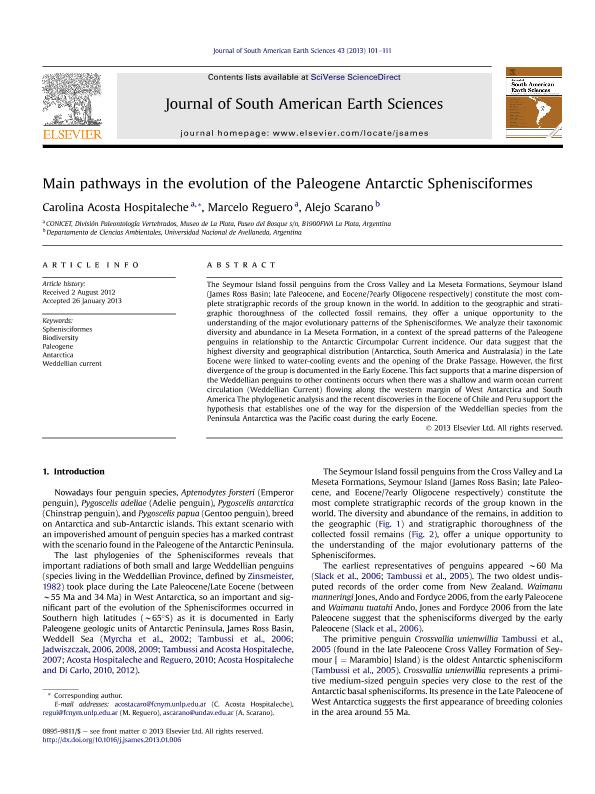Artículo
Main pathways in the evolution of the Paleogene Antarctic Sphenisciformes
Fecha de publicación:
04/2013
Editorial:
Elsevier
Revista:
Journal of South American Earth Sciences
ISSN:
0895-9811
Idioma:
Inglés
Tipo de recurso:
Artículo publicado
Clasificación temática:
Resumen
The Seymour Island fossil penguins from the Cross Valley and La Meseta Formations, Seymour Island (James Ross Basin; late Paleocene, and Eocene/?early Oligocene respectively) constitute the most complete stratigraphic records of the group known in the world. In addition to the geographic and stratigraphic thoroughness of the collected fossil remains, they offer a unique opportunity to the understanding of the major evolutionary patterns of the Sphenisciformes. We analyze their taxonomic diversity and abundance in La Meseta Formation, in a context of the spread patterns of the Paleogene penguins in relationship to the Antarctic Circumpolar Current incidence. Our data suggest that the highest diversity and geographical distribution (Antarctica, South America and Australasia) in the Late Eocene were linked to water-cooling events and the opening of the Drake Passage. However, the first divergence of the group is documented in the Early Eocene. This fact supports that a marine dispersion of the Weddellian penguins to other continents occurs when there was a shallow and warm ocean current circulation (Weddellian Current) flowing along the western margin of West Antarctica and South America The phylogenetic analysis and the recent discoveries in the Eocene of Chile and Peru support the hypothesis that establishes one of the way for the dispersion of the Weddellian species from the Peninsula Antarctica was the Pacific coast during the early Eocene.
Palabras clave:
Sphenisciformes
,
Biodiversity
,
Paleogene
,
Antarctica
,
Weddellian Current
Archivos asociados
Licencia
Identificadores
Colecciones
Articulos(CCT - LA PLATA)
Articulos de CTRO.CIENTIFICO TECNOL.CONICET - LA PLATA
Articulos de CTRO.CIENTIFICO TECNOL.CONICET - LA PLATA
Citación
Acosta Hospitaleche, Carolina Ileana Alicia; Reguero, Marcelo Alfredo; Scarano, Alejo Carlos; Main pathways in the evolution of the Paleogene Antarctic Sphenisciformes; Elsevier; Journal of South American Earth Sciences; 43; 4-2013; 101-111
Compartir
Altmétricas




